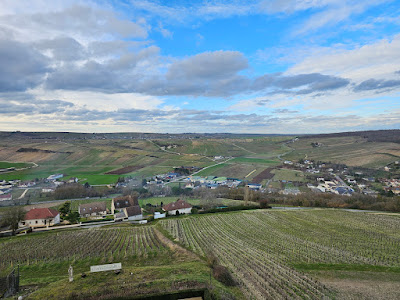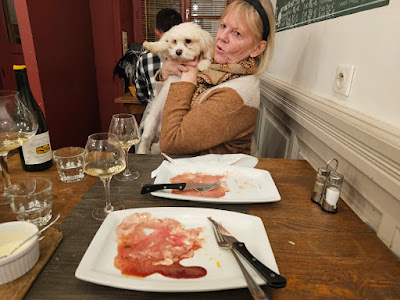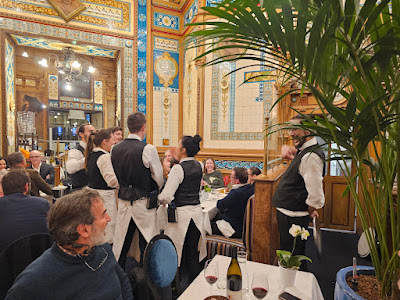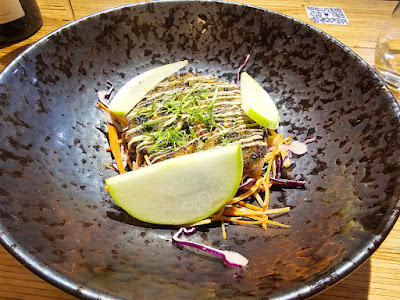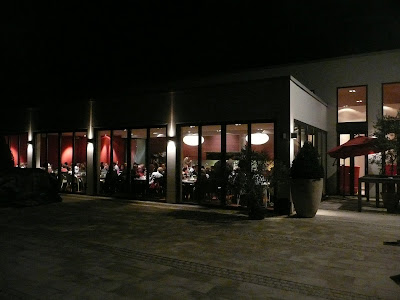I am an oyster lover. I eat Virginia oysters on the half shell regulary, when they are available. Typically, I buy them at the local supernarket in a bag containing a dozen oysters for less than US$10, shuck them myself at home, put on a record from my extensive LP collection and eat them with a dry white wine from my cellar.
Occasionally, I eat oysters from the East Coast.
 Picture: Christian Schiller with Oyster Guru Jon Rowley in Seattle tasting oysters and oyster wines: West Coast Oysters and Wine with Jon Rowley in Seattle, USA
Picture: Christian Schiller with Oyster Guru Jon Rowley in Seattle tasting oysters and oyster wines: West Coast Oysters and Wine with Jon Rowley in Seattle, USAWith an annual production of 5 million tonnes, China is by far the largest producer of oysters in the world, accounting for 85 percent of world output. The following 5 countries combined produce just 0.5 million tonnes: Korea (300.000), Japan (150.000), USA (150.000), France (75.000), Philippines (40.000).
Just 50.000 tonnes of oyster production are internationally traded. This is due to the very nature of oyster, which are highly perishable and potentially risky for human health if not properly handled.
France
With over 2,000 miles of coastline, France is the largest producer of oysters in Europe. In France, the oyster has been beloved by kings and peasants for thousands of years and today, the French continue to love these salty and briny treats from the sea. At bistros and brasseries around the country, you’ll find raw oysters on the menu–and many believe French oysters to be the best in the world.
In France, on both the Mediterranean and Atlantic coasts, oysters are grown in marshes and estuaries. Oysters thrive in saltwater and brackish water where changing tides help the mollusks grow strong shells. Many of France’s oysters come from shallow bays or lagoons.
In France, there are two kinds of oysters grown. The Belon is a native variety that used to dominate output but now makes up only about 1-2% of the oyster industry in France. Oyster production in France - as everywhere else in the world - is dominated today by the Pacific oyster.
Grade is important to the French when it comes to oysters. There are three rankings, according to maturity, and therefore meatiness: starting with Fine de Claire, progressing to Spéciale de Claire, and culminating with the much esteemed Pousse en Claire.
Size is the other important
component to consider. In France, oysters are costed by weight, and the
number assigned to an oyster indicates its size. Oysters are numbered
between 1 and 5; the higher the figure, the smaller the oysters. No.3 is
the most common size of oyster to appear on a restaurant menu.
While oysters are farmed throughout France, Normandy and Brittany are especially known for oysters, with the city of Cancale (near Mont St. Michel) dubbed “The Oyster Capital of Brittany.” There are numerous French regions famed for their particular oysters. Normandy produces the much-loved pulpy Isigny oyster, the nutty Saint-Vaast and the sweet Utah Beach. Brittany is celebrated for its firm and salty Cancale, its bracing Belon, and its plump and juicy Paimpol. Also look out for oysters from Arcachon Bay, which are originally wild, and oysters from the central west coast hubs of Île de Ré and Marennes-Oléron.
A French oyster eatery is called une huîtrerie. (It’s quite a mouthful to say, but once you get the hang of it, the word rolls all around the mouth like the juiciest of molluscs.) A huîtrerie serves its oysters freshly shucked — sometimes done so right in front of you — and its menu of options can at first be mind-boggling.
Cancale
Cancale, across the bay from Mont St-Michel, dubbed the "Oyster Capital of Brittany”, is home to 2.8 square miles of oyster beds ( 7.3 square kilometers) which harvest 25,000 tons of oysters each year. The large production is attributed to the high quality of plankton in Mont Saint-Michel Bay.
Some 30-40 companies produce oysters in the bay. Total production in the bay amounts to 5,000 tonnes of Pacific oysters and 1,000 tonnes of Belon oysters.
Fine de Claire
A Fine de Claire is an oyster that has undergone its last “affinage” in the 'claires'. These claires, which are connected to the open sea, are shallow closable ponds in the past used mainly for the production of salt. The taste has a higher liquid content and a delicate salty taste. The treatment gives them a less salty and iodic taste than if they come straight from the sea, and earns them the “fine” label, recognised by the EU’s protected geographical indication (PGI) category.
Les Parcs Saint Kerber and Tsaskaya OystersLes Parcs Saint Kleber: Oyster Tsarskaya from Saint Kerber are beautiful oysters that have been aged between 3 and 6 months. The name of the oysters are in tribute to the Russian czars that first introduced this delicacy in Brittany and as such, are farmed exclusively in Cancale. Upon contact on the palate, one will notice how briny the oysters are. Strong notes of the sea and sea mists are observed. Upon chewing the flesh, a pleasant and refreshing sweetness is released contrasting the strong saltiness of the oyster.
Tsarskaya Oysters
Domaine Pellé
Our Domaine takes its roots in Morogues, a village at the far eastern end of the Loire Valley. Our cellars are close to the village centre, nestling below our beautiful “Les Cris” red grape vineyard. In each of our vineyard plots in the neighbouring Menetou-salon and Sancerre appellations, we observe Mother Nature, cherishing and working with her so that she gives us her very best in return. In this part of the world, we think, make and drink wine; sharing ideas, a glass of wine or two, and the taste of our land, with our friends and customers. These lines are written by the current generation but they apply to Domaine Pellé from its very beginning. Over time, the world has accelerated but nature has stayed faithful, determining the work of the winemaker, year after year, with each new season. With the same devotion to his craft, the winemaker still slips through the cellar door late at night to check on the wines, only now he is wearing sneakers not clogs!
- Appellation: Menetou-Salon
- Owner: Paul-Henry & Anne Pellé
- Winemaker: Paul-Henry Pellé
- Varieties Grown: Sauvignon Blanc, Pinot Noir
- Age of Vines: 42 hectares. Age of vines: 20-60 years old.
- Altitude: 300-350 meters above sea level. Clay-limestone soils, more precisely Kimmeridgian marls
- Farming Methods: Organic conversion Biodynamic
See: Announcement: Loire Valley 2024 by ombiasy WineTours (Sunday, June 09 - Thursday June 20, 2024)












































